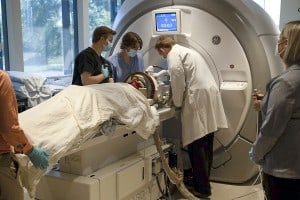There’s new hope for patients with hand tremor thanks to Focused Ultrasound, a procedure done with no incision and no hospital stay at our East Campus.
It’s designed for patients age 22 and over who have a diagnosis of essential tremor or tremor-dominant Parkinson’s disease, and whose condition has not responded to medication.
Patients should consult their neurologist and have a CT scan to make sure Focused Ultrasound is right for them.
A hand tremor can make activities many people take for granted – eating a favorite meal, typing an email to a friend, playing catch with a grandchild – difficult or impossible.
Regional One Health is offering new hope thanks to an incisionless outpatient procedure called MR-Guided Focused Ultrasound. Our East Campus Imaging Center is one of only a handful of locations in the nation offering this innovative treatment.
Neurosurgeon Aaron Bond, MD said focused ultrasound can be lifechanging for patients with essential tremor or tremor-dominant Parkinson’s disease. “Patients assume their tremor is a sign of old age and don’t realize there are treatments that can potentially eliminate their tremors,” he said. “We want to make sure our patients can get the care to go back to living comfortably.”
If a hand tremor is keeping you from the things you love, you might be a good candidate for focused ultrasound. The treatment is for patients age 22 and over with a confirmed diagnosis of essential tremor or tremor-dominant Parkinson’s.
Here are some other things to consider:
What are my symptoms, and how severe are they?

Focused Ultrasound is an alternative to medication and surgery for patients living with hand tremor. It’s a great option if medication hasn’t worked or if you want to avoid the risks of surgery.
Essential tremor and tremor-dominant Parkinson’s symptoms often begin gradually, usually on one side of the body. They include uncontrollable shaking for brief periods of time.
Tremors typically start in the hands and can also impact the voice or head. Often, the symptoms worsen during periods of emotional stress and purposeful movement.
Focused ultrasound is for patients whose tremor is bad enough to disrupt daily life and prompt them to consider surgery, Dr. Bond said.
He described a patient who came to him for help with severe tremor:
“She couldn’t feed herself. She couldn’t write. She couldn’t do any of the basic activities of daily living,” he said. “By the end of the case, her tremor had completely stopped. I saw her in the office three days later, and she told me she’s eating her peas with her fork.”
What care have I received so far?
To have the focused ultrasound treatment, patients should be under the care of a neurologist who specializes in movement disorders and has given them a confirmed diagnosis of essential tremor or tremor-dominant Parkinson’s disease.
Dr. Bond said focused ultrasound is for patients whose tremors have not responded to prescribed medications like propranolol or primidone. This is the case for 30-50 percent of patients.
Am I healthy enough to undergo the procedure?
Prior to receiving treatment, your physician will need to clear you via a physical exam.
Be sure to discuss all your medical conditions with your physician so they can properly evaluate whether the treatment is a good option for you. Conditions like kidney disease can prevent a patient from safely undergoing focused ultrasound.

Patients must be able to tolerate an MRI. The Focused Ultrasound procedure involves lying still on a treatment table that moves in and out of an MRI over the course of several hours.
Can I tolerate an MRI?
Focused ultrasound is guided by MRI, which means patients must be able to tolerate being in and out of an MRI machine for several hours with either no sedation or conscious sedation.
During treatment, half of the body, from head to mid-torso, is in the MRI scanner. The treatment bed moves in and out of the scanner periodically. Patients must be conscious because they will be asked to perform tasks, like drawing a spiral, that confirm the treatment is working.
All other standard regulations for having an MRI apply.
You must be able to lie still in the same position for 3-4 hours. Patients with metallic implants like pacemakers, neuro-stimulators, spine or bone fixation devices, total joints, metal clips, screws, etc., need to consult with their physician, as metallic implants must be MRI-compatible to prevent injury to the patient from the MRI’s strong magnetic field.
What else do I need to know?
You’ll need to have a CT scan to determine if the shape and thickness of your skull are suitable for treatment. Focused ultrasound sends sound waves through your skull to treat the portion of the brain that causes tremors, and some skulls are not compatible.
How can I find out more?
The best way to know if you are a candidate for focused ultrasound is to talk with a neurologist specializing in movement disorders.